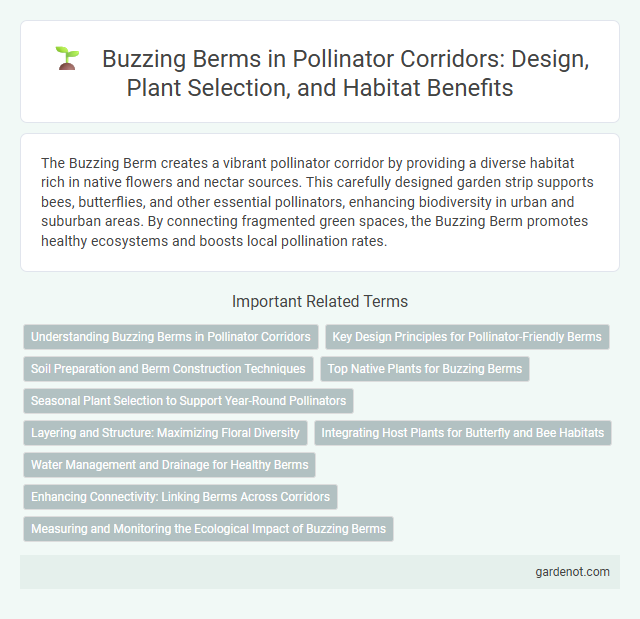The Buzzing Berm creates a vibrant pollinator corridor by providing a diverse habitat rich in native flowers and nectar sources. This carefully designed garden strip supports bees, butterflies, and other essential pollinators, enhancing biodiversity in urban and suburban areas. By connecting fragmented green spaces, the Buzzing Berm promotes healthy ecosystems and boosts local pollination rates.
Understanding Buzzing Berms in Pollinator Corridors
Buzzing berms serve as vital components within pollinator corridors by providing concentrated habitats rich in native flowering plants that support diverse pollinator species like bees, butterflies, and hummingbirds. These berms enhance connectivity between fragmented habitats, facilitating pollinator movement and genetic diversity across landscapes. Effective buzzing berms incorporate layered vegetation and seasonal blooms, maximizing nectar and pollen availability throughout the pollination season.
Key Design Principles for Pollinator-Friendly Berms
Buzzing berms incorporate native flowering plants arranged to provide continuous bloom cycles, enhancing habitat connectivity for pollinators across urban and rural landscapes. Soil composition and berm slope are tailored to ensure proper drainage and microclimate conditions, promoting plant health and pollinator activity. Structural diversity within the berm supports diverse pollinator species by offering nesting sites, shelter, and varied foraging opportunities essential for sustaining pollinator populations.
Soil Preparation and Berm Construction Techniques
Effective soil preparation for buzzing berms involves deep tilling to enhance aeration and drainage, combined with organic matter incorporation to boost nutrient content and microbial activity. Berm construction techniques prioritize layering native flowering plants with varied bloom periods to create continuous habitat corridors that support diverse pollinator populations. Strategic contouring of soil berms maximizes sun exposure and moisture retention essential for pollinator-friendly plant growth.
Top Native Plants for Buzzing Berms
Top native plants for buzzing berms include milkweed, purple coneflower, and goldenrod, which provide essential nectar and pollen sources for pollinators. These species support diverse pollinator populations by sustaining bees, butterflies, and hummingbirds throughout the growing season. Incorporating native grasses such as little bluestem enhances habitat structure and promotes ecological balance within pollinator corridors.
Seasonal Plant Selection to Support Year-Round Pollinators
Buzzing berms incorporate a carefully curated selection of native wildflowers and flowering shrubs that bloom sequentially from early spring through late fall, ensuring continuous nectar and pollen availability. Seasonal plant selection prioritizes species like milkweed, coneflowers, goldenrod, and asters, which support a diverse array of pollinators including bees, butterflies, and hummingbirds. This strategic layering of bloom times enhances habitat connectivity and sustains pollinator populations throughout the entire growing season.
Layering and Structure: Maximizing Floral Diversity
Buzzing berms maximize floral diversity through strategic layering and structured plant placement that supports continuous bloom cycles. Vertical and horizontal layering create microhabitats, attracting a wide range of pollinators like bees, butterflies, and hummingbirds by offering diverse nectar sources. This structured approach enhances ecosystem resilience and promotes sustained pollinator activity across blooming seasons.
Integrating Host Plants for Butterfly and Bee Habitats
Buzzing berms serve as vital pollinator corridors by integrating native host plants that support the life cycles of butterflies and bees, enhancing biodiversity and ecological resilience. Strategically selected host plants provide essential nectar and larval food sources, promoting healthy pollinator populations while fostering habitat connectivity. This targeted planting approach ensures continuous foraging and breeding grounds, crucial for sustaining robust pollinator communities across fragmented landscapes.
Water Management and Drainage for Healthy Berms
Buzzing berms improve water management by facilitating efficient drainage, preventing waterlogging that can harm pollinator habitats. Engineered berms incorporate porous soil and native plants, enhancing infiltration and reducing surface runoff. Properly managed drainage systems in these berms maintain soil moisture balance, promoting healthy growth of flowering plants vital for pollinators.
Enhancing Connectivity: Linking Berms Across Corridors
Buzzing berms serve as vital linkages, enhancing connectivity by connecting isolated habitats within pollinator corridors. These strategically planted berms provide continuous foraging and nesting resources, facilitating safe movement for diverse pollinator species such as bees, butterflies, and hummingbirds. Integrating buzzing berms into landscape planning significantly boosts ecological network resilience and supports pollinator population stability.
Measuring and Monitoring the Ecological Impact of Buzzing Berms
Measuring and monitoring the ecological impact of Buzzing Berms involve tracking pollinator species diversity, population density, and foraging behavior within the corridor. Tools such as remote sensing, insect traps, and geographic information systems (GIS) enable precise data collection on habitat connectivity and floral resource availability. Regular ecological assessments provide critical insights into the effectiveness of Buzzing Berms in enhancing pollination services and supporting biodiversity conservation.
Buzzing berm Infographic

 gardenot.com
gardenot.com